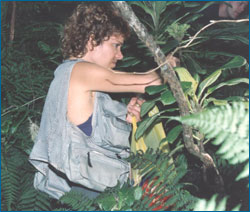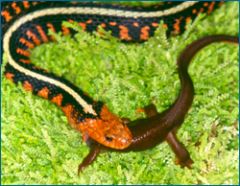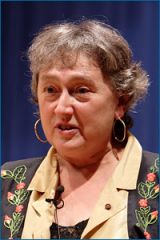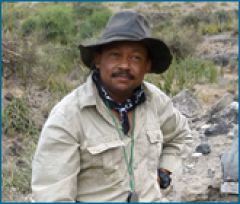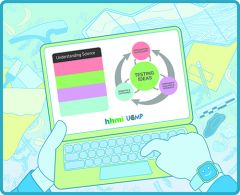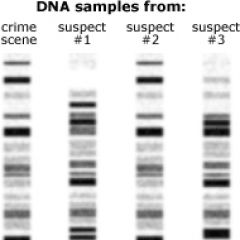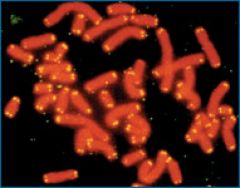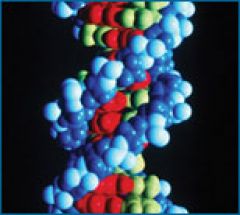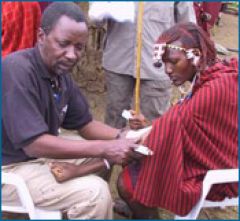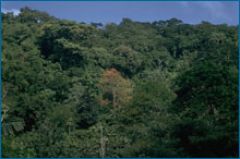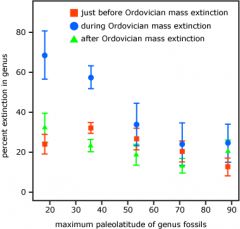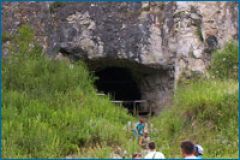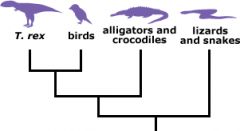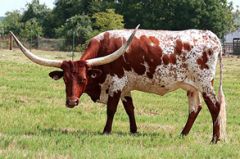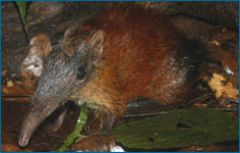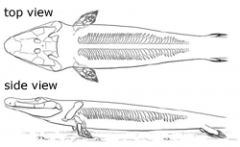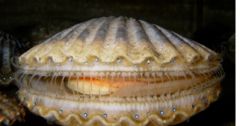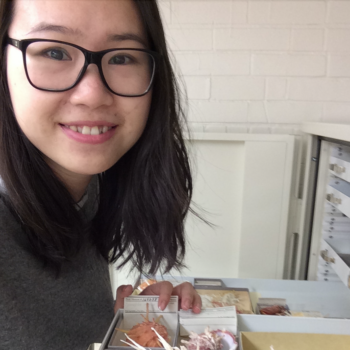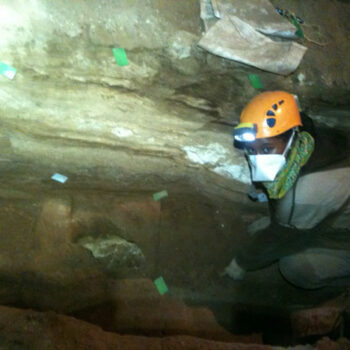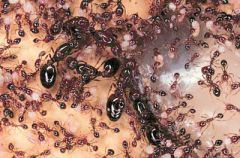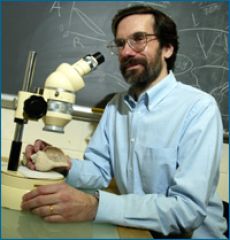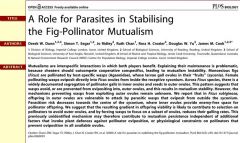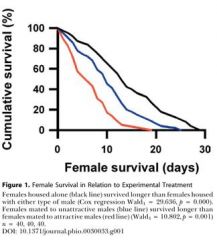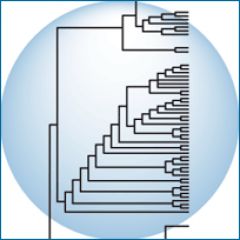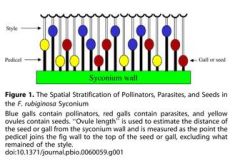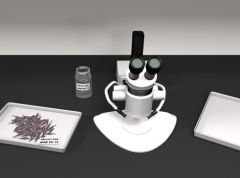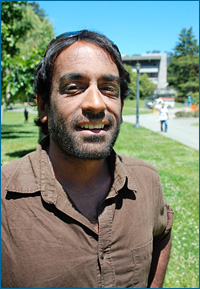Found 41 resources for the concept:
Scientists can test ideas about events and processes long past, very distant, and not directly observable.
Aloha, spider style! The work of Rosemary Gillespie
Grade Level(s):
- 9-12
- 13-16
- General
Source:
- UC Museum of Paleontology
Resource type:
- Research profile
Time: one class period
Overview
This research profile follows Dr. Rosemary Gillespie to Hawaii as she evaluates hypotheses about the evolution of the colorful happy-face spider.
Biological warfare and the coevolutionary arms race
Grade Level(s):
- 9-12
- 13-16
- Advanced
- General
Source:
- UC Museum of Paleontology
Resource type:
- Article
Time: 45 minutes
Overview
The rough-skinned newt looks harmless enough but is, in fact, packed full of one of the most potent neurotoxins known to man. Find out how an evolutionary arms race has pushed these mild-mannered critters to the extremes of toxicity and how evolutionary biologists have unraveled their fascinating story.
Cells within cells: An extraordinary claim with extraordinary evidence
Grade Level(s):
- 13-16
- Advanced
- General
Source:
- Understanding Science
Resource type:
- Article
Time: 30 minutes
Overview
When biologist Lynn Margulis revived the strange-sounding idea that the merging of cells played a prominent role in the evolution of complex life, the scientific community roundly rejected the notion. Today, this idea is accepted as a textbook fact. Learn more about the evidence and social factors that spurred the acceptance of this key aspect of evolutionary theory.
This article is available from the Understanding Science website.
CSI: Olduvai Gorge. The work of Jackson Njau
Grade Level(s):
- 9-12
- 13-16
Source:
- UC Museum of Paleontology
Resource type:
- Research profile
Time: 40 minutes
Overview
This research profile follows paleoanthropologist Jackson Njau as he investigates ancient predators, like crocodiles and large cats, in an effort to understand how these organisms shaped the evolution of our human ancestors.
Determining Age of Rocks and Fossils
Grade Level(s):
- 9-12
- 13-16
Source:
- McKinney, Frank
Resource type:
- Lab activity
Time: One to two class periods
Overview
In this series of lessons students learn the basic principles used to determine the age of rocks and fossils by using half-life in radioactive decay and stratigraphy.
Discovering mass extinctions in the fossil record
Grade Level(s):
- 13-16
Source:
- UC Museum of Paleontology
Resource type:
- Online activity or lab
Time: 2 hours
Overview
This activity (suitable for distance learning) is designed to introduce students to the nature and process of science through the discovery of mass extinctions in the fossil record. Students will explore the fossil record of brachiopods and bivalves using the Paleobiological Database, identify patterns in their data, and generate and evaluate hypotheses. They will also document this process using the Understanding Science flowchart. Clicking the link above will download the Word file for this lesson.
Evo in the news: Evolution at the scene of the crime
Grade Level(s):
- 9-12
- 13-16
- General
Source:
- UC Museum of Paleontology
Resource type:
- Evo in the News article
Time: 15 minutes
Overview
This news brief, from March 2006, describes how DNA fingerprinting is being used to prosecute and exonerate the accused. DNA fingerprinting relies on the processes of mutation and genome evolution.
Evo in the news: Evolution in the fast lane?
Grade Level(s):
- 9-12
- 13-16
- Advanced
- General
Source:
- UC Museum of Paleontology
Resource type:
- Evo in the News article
Time: 20 minutes
Overview
Have humans, with all of our technological advances, exempted ourselves from further evolution? Perhaps not. This news brief, from February 2008, examines genetic research which suggests that human evolution may haved actually accelerated in our recent history.
Evo in the news: Genealogy enthusiasts mine DNA for clues to evolutionary history
Grade Level(s):
- 9-12
- 13-16
- Advanced
- General
Source:
- UC Museum of Paleontology
Resource type:
- Evo in the News article
Time: 15 minutes
Overview
This news brief, from November 2007, turns an evolutionary lens on businesses that use DNA for genealogy research and, in the process, illuminates what their genetic tests really track.
Evo in the news: Got lactase?
Grade Level(s):
- 9-12
- 13-16
- Advanced
- General
Source:
- UC Museum of Paleontology
Resource type:
- Evo in the News article
Time: 20 minutes
Overview
The ability to digest milk is a recent evolutionary innovation that has spread through some human populations. This news brief from April 2007 describes how evolution has allowed different human populations to take advantage of the nutritional possibilities of dairying and links evolution with the prevalence of lactose tolerance among people of different ethnicities.
Evo in the news: Hotspots for evolution
Grade Level(s):
- 9-12
- 13-16
- General
Source:
- UC Museum of Paleontology
Resource type:
- Evo in the News article
Time: 15 minutes
Overview
Why are there so many different species in the tropics? This news brief, from June 2006, suggests why: warmer weather may be linked to a quicker pace for evolution.
Evo in the News: Lessons for today in ancient mass extinctions
Grade Level(s):
- 13-16
- Advanced
Source:
- UC Museum of Paleontology
Resource type:
- Evo in the News article
Time: 30 minutes
Overview
This news brief, from May 2012, describes new research on the end-Ordovician mass extinction and the lessons we might glean about extinctions going on around us today.
Evo in the news: Making sense of ancient hominin DNA
Grade Level(s):
- 9-12
- 13-16
- Advanced
- General
Source:
- UC Museum of Paleontology
Resource type:
- Evo in the News article
Time: 10 minutes
Overview
In March 2010 German researchers announced that they had managed to extract DNA from the 40,000 year old fossil bone from a child discovered in a Siberian cave and that it didn't match up to the known genetic sequences of either humans or Neanderthals! This news brief examines the evidence in more detail and considers what that evidence might — or might not — mean about such claims.
Evo in the news: More than morphology
Grade Level(s):
- 9-12
- 13-16
- General
Source:
- UC Museum of Paleontology
Resource type:
- Evo in the News article
Time: 15 minutes
Overview
This news brief, from August 2006, describes recent research on T. rex, with a special focus on how paleontologists move beyond the shape of the animal's bones to learn about aspects of its life that don't fossilize very well: its physiology, sensory abilities, and population dynamics.
Evo in the news: No more mystery meat
Grade Level(s):
- 9-12
- 13-16
- General
Source:
- UC Museum of Paleontology
Resource type:
- Evo in the News article
Time: 20 minutes
Overview
This news brief from April 2013 describes new research on the origin of American cattle breeds. The story told by the cows' genes crisscrosses the trajectory of human evolutionary history from wild aurochs that lived alongside Neanderthals, to Christopher Columbus and, ultimately, the American West.
Evo in the news: Omicron and the case of the hidden evolution
Grade Level(s):
- 9-12
- 13-16
- General
Source:
- UC Museum of Paleontology
Resource type:
- Evo in the News article
Time: 30 min
Overview
This news brief from January 2022, explores the evolutionary mystery at the heart of the Omicron COVID-19 surge.
Evo in the news: Quick bites and quirky adaptations
Grade Level(s):
- 9-12
- 13-16
- General
Source:
- UC Museum of Paleontology
Resource type:
- Evo in the News article
Time: 15 minutes
Overview
Trap-jaw ants made headlines with the record-breaking speed of their jaws and a quirky behavior: flinging themselves into the air using the power of their mandibles. This news brief from October 2006 reveals the evolutionary story behind the headlines.
Evo in the news: The new shrew that’s not
Grade Level(s):
- 9-12
- 13-16
- General
Source:
- UC Museum of Paleontology
Resource type:
- Evo in the News article
Time: 20 minutes
Overview
This news brief from March of 2008 describes scientists' discovery of a new mammal species, a giant elephant shrew. Though elephant shrews resemble regular shrews, recent genetic evidence suggests that elephant shrews actually sprang from a much older (and perhaps more charismatic) branch of the tree of life - the one belonging to elephants and their relatives.
Evo in the news: Tracking SARS back to its source
Grade Level(s):
- 9-12
- 13-16
- General
Source:
- UC Museum of Paleontology
Resource type:
- Evo in the News article
Time: 15 minutes
Overview
This news brief, from January of 2006, traces the source of the SARS virus. Using phylogenetics, biologists have come up with a plausible path of transmission which may help us prevent future outbreaks of diseases such as HIV, SARS, and West Nile virus.
Evo in the news: What has the head of a crocodile and the gills of a fish?
Grade Level(s):
- 9-12
- 13-16
- General
Source:
- UC Museum of Paleontology
Resource type:
- Evo in the News article
Time: 15 minutes
Overview
This news brief, from May 2006, reviews what is likely to be the most important fossil find of the year: Tiktaalik helps us understand how our own ancestors crawled out of the water and began to walk on dry land.
Evolution and Antibiotic Resistance
Grade Level(s):
- 9-12
- 13-16
Source:
- WGBH
Resource type:
- Classroom activity
Time: One to three class periods
Overview
Students learn why evolution is at the heart of a world health threat by investigating the increasing problem of antibiotic resistance in such menacing diseases as tuberculosis.
Evolution connection: Photosynthesis 2
Grade Level(s):
- 13-16
Source:
- UC Museum of Paleontology
Resource type:
Time: 5 minutes
Overview
This short slide set explains uniformity and variation in the process of photosynthesis across all life using evolutionary history. Save the slide set to your computer to view the explanation and notes that go along with each slide.
Evolution of human skin color
Grade Level(s):
- 9-12
- 13-16
Source:
- Smithsonian National Museum of Natural History
Resource type:
- Classroom activity
Time: Seven to ten 50 minute class periods
Overview
Students examine evidence for the relationship between UV and melanin in other animals; investigate the genetic basis for constitutive skin color humans; learn to test for natural selection in mouse fur color; investigate how interactions between UV and skin color in humans can affect fitness; and explore data on migrations and gene frequency to show convergent evolution of skin color.
Exploring KT extinction patterns
Grade Level(s):
- 13-16
- Advanced
Source:
- UC Museum of Paleontology
Resource type:
- Lab activity
Time: 2-3 hours
Overview
Students will be introduced to a data set about mollusk genera that survived and did not survive the KT extinction event. They will formulate hypotheses regarding extinction patterns and mechanisms and analyze the data for evidence relevant to those hypotheses.
Extinction vulnerability with Shan Huang, David Jablonski, and Stewart Edie
Grade Level(s):
- 9-12
- 13-16
Source:
- UC Museum of Paleontology
Resource type:
- Article
- Classroom activity
Time: 1.5 hrs
Overview
In this article (and the linked assignments and student readings), students examine and interpret data that Shan, David, and Stewart used to investigate whether the mollusk species that humans eat are inherently vulnerable to extinction. Use the tabs at the bottom of the feature to find related videos, assignments, and lessons to build this example into a lesson sequence on extinction.
Extinction with Melissa Kemp and Liz Hadly
Grade Level(s):
- 9-12
- 13-16
Source:
- UC Museum of Paleontology
Resource type:
- Article
- Classroom activity
Time: 1.5 hours
Overview
In this article (and the linked assignments and student readings), students examine and interpret data that Melissa and Liz used to study the extinction bias in Caribbean lizards. Use the tabs at the bottom of the feature to find related videos, assignments, and lessons to build this example into a lesson sequence on extinction.
Fire ants invade and evolve
Grade Level(s):
- 9-12
- 13-16
- Advanced
- General
Source:
- UC Museum of Paleontology
Resource type:
- Article
Time: 40 minutes
Overview
Understanding the evolution of fire ants may help scientists control the spread of these pests, which have already taken over much of the U.S.
From the origin of life to the future of biotech: The work of Andy Ellington
Grade Level(s):
- 9-12
- 13-16
- General
Source:
- UC Museum of Paleontology
Resource type:
- Research profile
Time: 30-40 minutes
Overview
This research profile examines how scientist Andy Ellington has co-opted the power of artificial selection to construct new, useful molecules in his lab. The results of his work could help protect us from terrorist attacks and fight HIV and cancer.
High altitude adaptations: The work of Emilia Huerta-Sánchez
Grade Level(s):
- 13-16
- Advanced
Source:
- UC Museum of Paleontology
Resource type:
- Research profile
Time: 30 minutes
Overview
This research profile follows statistician and population geneticist Emilia Huerta-Sánchez as she studies the adaptations that allow Tibetan highlanders to live 13,000 feet above sea level without developing altitude sickness.
How boogieing birds evolved: The work of Kim Bostwick
Grade Level(s):
- 9-12
- 13-16
- General
Source:
- UC Museum of Paleontology
Resource type:
- Research profile
Time: 30 minutes
Overview
This research profile follows ornithologist Kim Bostwick through the jungles of Ecuador and the halls of museums as she investigates the evolution of an exotic bird's complex mating dance.
How to survive a mass extinction: The work of David Jablonski
Grade Level(s):
- 9-12
- 13-16
- General
Source:
- UC Museum of Paleontology
Resource type:
- Research profile
Time: 40 minutes
Overview
Through detailed analysis of patterns in the fossil record, scientist David Jablonski reconstructs the rules that helped dictate who lived and died in past mass extinctions. This research profile describes his surprising discoveries and their disturbing implications for the biodiversity crisis today.
It takes teamwork: How endosymbiosis changed life on Earth
Grade Level(s):
- 9-12
- 13-16
- Advanced
- General
Source:
- UC Museum of Paleontology
Resource type:
- Article
Time: 30-40 minutes
Overview
You might be surprised to learn that descendants of an ancient bacterium are living in every cell of your body! Find out how endosymbiosis factored into the evolution of your own cells and learn about a modern example of this process.
Journal Club Toolkit
Grade Level(s):
- 13-16
Source:
- UC Museum of Paleontology
Resource type:
- Annotated journal article
Time: Several class periods
Overview
This set of teaching materials aims to help instructors engage their students with the primary literature in evolutionary biology through a "journal club" that can be implemented in a discussion section or smaller class. It includes several helpful tools: annotated articles, a reading guide, additional suggested reading, and tips for students leading a discussion of a journal article.
Mate choice and fitness consequences
Grade Level(s):
- 13-16
Source:
- UC Museum of Paleontology
Resource type:
- Annotated journal article
Time: 1 hour
Overview
Students read a 2005 paper on the fitness consequences of mate choice alongside an interactive guide that asks the reader to answer key questions about each section of the article.
Omicron y el caso de la evolución escondida
Grade Level(s):
- 9-12
- 13-16
- General
Source:
- UC Museum of Paleontology
Resource type:
- Evo in the News article
Time: 30 min
Overview
Durante el último mes, las cepas del SARS-CoV-2 Omicron han dominado los noticiarios del mundo. Esta variante de rápida transmisión ha llevado a limitar viajes, a cancelar planes de vacaciones, al agotamiento de los kits de pruebas, a la vuelta de los confinamientos, y además a un asombroso número de nuevos casos de COVID-19. Los científicos rápidamente se han puesto a estudiar Omicron, intentando entender qué tan rápido se transmite, qué tanto nos enferma, y si es resistente a los tratamientos, a las vacunas, y a los anticuerpos de infecciones de COVID previas. Necesitamos revisar todas estas cuestiones porque Omicron es muy diferente de otras cepas de coronavirus. Omicron ha acumulado más de 50 nuevas mutaciones en comparación con la cepa que empezó la pandemia. Además Omicron no es un descendiente de la cepa Delta, responsable de la anterior ola de infecciones. De hecho, Omicron es tan diferente de otras variantes que parece que ha estado evolucionando por su cuenta durante muchos meses. Y esto nos conduce a otro misterio que los científicos están tratando de resolver: ¿dónde estaba Omicron escondido mientras toda esta evolución tenía lugar?
Phylogenetic systematics, a.k.a. evolutionary trees
Grade Level(s):
- 13-16
- Advanced
- General
Source:
- UC Museum of Paleontology
Resource type:
- Tutorial
Time: 20 minutes
Overview
Learn about phylogenetic systematics, the study of the evolutionary relationships among organisms, and how the field is shaping biological research today.
Stabilization of the fig-pollinator mutualism
Grade Level(s):
- 13-16
Source:
- UC Museum of Paleontology
Resource type:
- Annotated journal article
Time: 1 hour
Overview
Students read a 2008 paper on the role of parasites in stabilizing the fig-pollinator mutualism alongside an interactive guide that explains each section of the paper and draws the reader's attention to important points in the article.
Stickleback Evolution Virtual Lab
Grade Level(s):
- 9-12
- 13-16
Source:
- Howard Hughes Medical Institute
Resource type:
- Online activity or lab
Time: 3 hours
Overview
This virtual lab teaches skills of data collection and analysis to study evolutionary processes using stickleback fish and fossil specimens.
The causes of mutation with Molly Przeworski and Felix Wu
Grade Level(s):
- 13-16
- Advanced
Source:
- UC Museum of Paleontology
Resource type:
- Classroom activity
Time: 1.5 hours
Overview
In this article (and the linked assignments and student readings), students examine and interpret data that Molly and Felix used to study the causes of mutations that matter most for evolution. Use the tabs at the bottom of the feature to find related videos, assignments, and lessons to build this example into a lesson sequence on mutation.
Using trees to uproot HIV: The work of Satish Pillai
Grade Level(s):
- 9-12
- 13-16
- Advanced
- General
Source:
- UC Museum of Paleontology
Resource type:
- Research profile
Time: 30 minutes
Overview
This research profile follows scientist Satish Pillai as he studies the evolution of HIV within infected individuals. His research uses the tools of phylogenetics to investigate vaccine development and the possibility of curing the disease.
What does it mean to be human?
Grade Level(s):
- 9-12
- 13-16
Source:
- Smithsonian National Museum of Natural History
Resource type:
- Classroom activity
Time: 8 x 50-minute class periods
Overview
In this set of advanced lessons, students use different types of data to infer/interpret phylogenies among domains, within the vertebrates, and within primates while reflecting on how they answer the question "What do you think it means to be human?" and choose a characteristic that changed substantially in the human family tree to develop a scientific argument based on evidence for when the character evolved.

